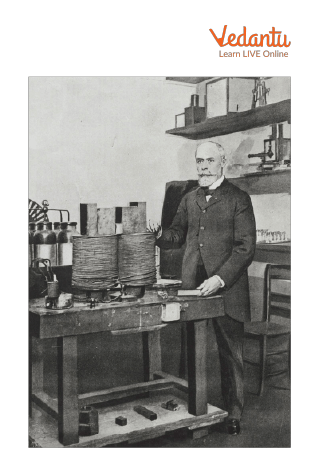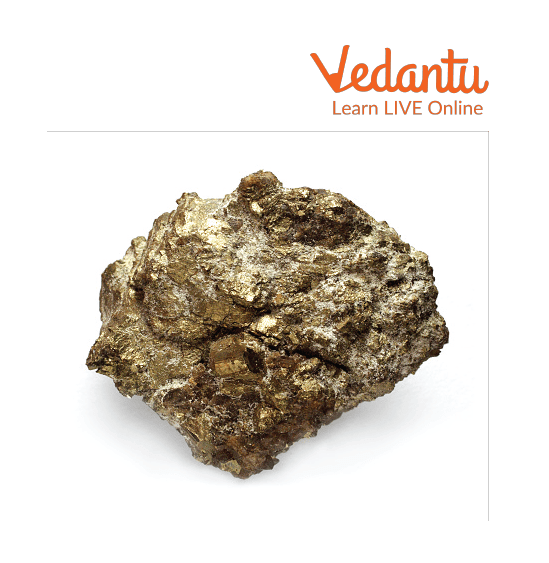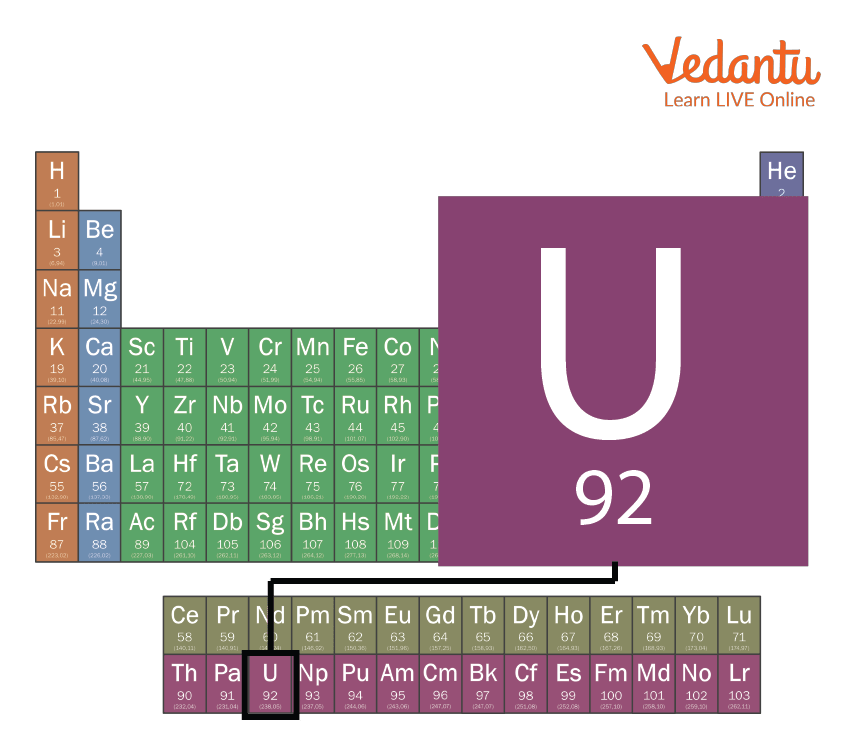




What is Uranium?
Uranium is a silvery-grey metal. It belongs to the actinide series of the periodic table. It occurs near the beginning of the actinide series. It has 92 protons and has 92 electrons out of which 6 are valence electrons.

Uranium
Uranium is weakly radioactive and it contributes to low levels of natural background radiation. Radium is always found with uranium ores because uranium is radioactive and always decaying. It plays an important role in the environment as it is used in nuclear power generation. Uranium is slightly paramagnetic.
Uranium Atomic Number and Symbol
Uranium is a chemical element which has the symbol U and has atomic number 92. Atomic mass of uranium is 238u.

Uranium Atomic Number
Who Discovered Uranium?
Uranium was discovered in 1789 by Martin Klaproth who is a German chemist. He isolated an oxide of uranium when he was analysing pitchblende samples. He named his discovery “Uran” after the planet Uranus which had been discovered eight years earlier.

The Discovery of Uranium Rays
Occurrence of Uranium
Uranium is found in many areas of the earth’s crust. Uranium deposits occur in association with igneous and sedimentary rocks. Uranium occurs naturally in low concentrations in soil, rock, and water and it is commercially extracted from uranium-bearing minerals such as uraninite. Uranium ore can be mined from open pits and underground excavations. This ore then can be crushed and treated at a mill to separate the metal uranium from the ore.
Uranium may be dissolved directly from the ore deposits in the ground. Uranium which is mined from the earth is stored, handled, and sold as uranium oxide concentrate.

Uranium Ore
Properties of Uranium
Uranium is a hard and heavy metal, silvery-white in colour. It is very dense, being 1.6 times more than lead.
It is solid at room temperature.
It is chemically toxic and its toxicity is more dangerous than its radioactivity.
It is reasonably soluble in water.
It has no taste and no smell.
Its powder is flammable and a fire hazard.
In the presence of an ultraviolet or black light, uranium makes the glass glow bright green.
In air, it tarnishes and when finely divided, it breaks into flames.
Uses of Uranium
Uranium is used in nuclear weapons.
It is also used in nuclear power plants.
Radium is always found in uranium ores because uranium is radioactive.
It is nowadays used to power commercial nuclear reactors that produce electricity and also to produce isotopes used for medical, industrial, and defence purposes around the world.
Uranium Periodic Table
Uranium is a chemical element on the periodic table. It is located in the seventh period in the periodic table. While it is easy to find many elements in the periodic table, uranium is placed below the main body of the periodic table in the actinide series which are transition metals.

Uranium in the Periodic Table
Solved Questions
1. What happens to uranium after use?
Ans: Uranium undergoes radioactive decay very slowly after use.
2. How long will uranium stay in the body?
Ans: Uranium can stay in the bones for a long time. The half-life of uranium is 70-200 days, this is the time that uranium takes for half of it to leave the bones. Most of it which is not in bones leaves the body in 1-2 weeks.
3. Is uranium a hard metal?
Ans: Uranium is a dense, hard, and heavy metal having the highest atomic mass.
Summary
Uranium is a heavy metal which has been used as an abundant source of energy for over 60 years. It is important as it provides us with nuclear fuel that is used to generate electricity. It occurs in most rocks and in earth’s crust in the form of tin, tungsten, and molybdenum. It occurs in seawater and it can be recovered from oceans. Uranium occurs in three different forms known as isotopes. It has atomic number 92 and it has the highest atomic mass, that is, 238u. It is chemically toxic. It is radioactive.
FAQs on Uranium
1. What cancers are caused by uranium?
The exposure to alpha particles from breathing in high uranium concentrations can result in lung cancer. Additionally, uranium is a hazardous substance, which means that kidney damage from uranium consumption can occur much more quickly than tumours of the bone or liver due to uranium's radioactive effects.
2. Can you touch uranium?
Uranium is a toxic chemical. You can touch it but if you touch it directly with your hands, you should wash your hands after touching and you should not eat it because of its toxicity.
3. Is uranium a liquid?
Uranium can be a solid, liquid, or gas within a reasonable range of temperature but it is solid at room temperature.
4. Is uranium stable?
No, Uranium is highly unstable. Because of the instability of its nucleus, uranium is radioactive by nature and is constantly decaying in search of a more stable configuration. In actuality, it was the element uranium that allowed for the discovery of radioactivity.









